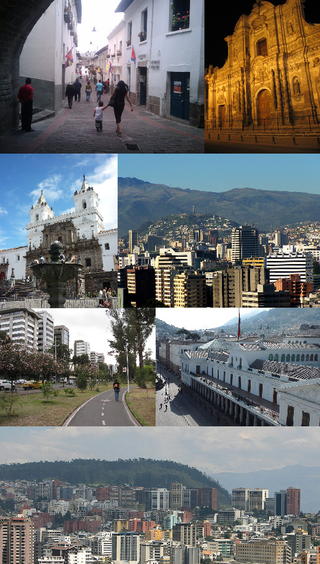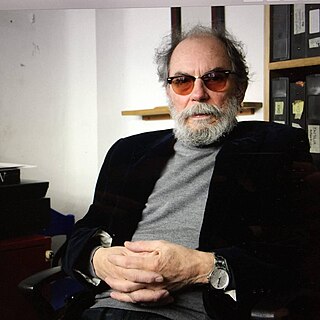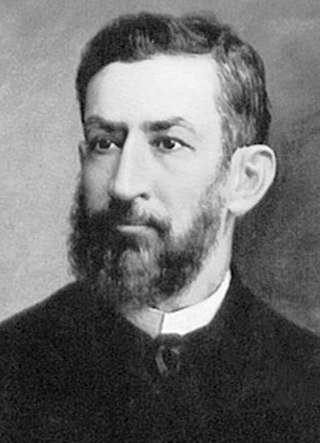
Quito, formally San Francisco de Quito, is the capital of Ecuador, with an estimated population of 2.8 million in its urban area. It is also the capital of the province of Pichincha. Quito is located in a valley on the eastern slopes of Pichincha, an active stratovolcano in the Andes, at an elevation of 2,850 m (9,350 ft), making it the second-highest capital city in the world.

Juan María Montalvo y Fiallos was an Ecuadorian author and essayist.

Oswaldo Guayasamín was an Ecuadorian painter and sculptor of Kichwa and Mestizo heritage.

Arturo Rivera was a Mexican painter based in Mexico City.

Eduardo Kingman Riofrío was an Ecuadorian artist. He is considered one of Ecuador's greatest artists of the 20th century, among the art circles of other master artists such as Oswaldo Guayasamín and Camilo Egas.

Jorge Enrique Adoum was an Ecuadorian writer, poet, politician, and diplomat. He was one of the major exponents of Latin American poetry. His work received such prestigious awards as the first Casa de las Américas Prize in Cuba, the most important honor in Latin American letters. Though hailed by Nobel Prize winner Pablo Neruda as the best poet of his generation in Latin America, Adoum’s work is unknown in the English-speaking world.
Cumbayá is a rural parish of the Metropolitan District of Quito in the Pichincha Province, Ecuador. It is located east of Quito, in the Tumbaco Valley northwest of the Ilaló volcano, in the San Pedro River valley, a tributary of the Guayllabamba River.
Aníbal Villacís was a master painter from Ecuador who used raw earthen materials such as clay and natural pigments to paint on walls and doors throughout his city when he could not afford expensive artist materials. As a teenager, Villacís taught himself drawing and composition by studying and recreating the illustrated ad posters for bullfights in Quito. In 1952, Jose Maria Velasco Ibarra, former President of Ecuador, discovered Villacís and offered him a scholarship to study in Paris.
Oswaldo Viteri is an Ecuadorian neo-figurative artist. Viteri gained recognition for his assemblage work, but has worked in a wide variety of media, including painting, drawing, printmaking, and mosaics. He began his education as a student of architecture at the Central University of Quito in 1951. Viteri worked in the workshop of Oswaldo Guayasamín and in 1959 assisted him on a mural commission for the Ministry of Public Works. During the 1960s he focused on painting and studying anthropology and folklore. In 1966, Viteri finished his degree in architecture and was appointed director of the Ecuadorian Institute of Folklore. He began to explore more experimental techniques of making art by incorporating collage and objects into his canvases. He made his first assemblage works in 1968 and appeared in his first "happening" that same year in Quito. He began to exhibit his work internationally in the 1960s, including in the 1964 Biennale of Córdoba, Argentina, and in the 1969 São Paulo Biennial for which he received honorable mention. His work became more sculptural in the 1970s as he began his Multiples series of assemblage works that use rag dolls and found objects. He has been twice candidate to the Prince of Asturias Awards. Mr. Viteri's house in northern Quito is now a museum, welcoming visitors by appointment.

Juan León Mera Martínez was an Ecuadorian essayist, novelist, politician and painter. His best-known works are the Ecuadorian National Hymn and the novel Cumandá (1879). Additionally, in his political career, he was a functionary of president Gabriel García Moreno.
Eduardo X Arroyo is an Ecuadorian painter.
José Carreño is an Ecuadorian painter who studied in Paris. His first important group exhibition was held in 1965 when he attended the Latin American Painting Hall in Braniff, Texas, United States. During this time, his work revolved around the suburban based expressionism. Perhaps this exhibit paved the way for the international projection of Carreño's work. Shortly after the event his name became well known in many countries.

Frank Lobdell was an American painter, often associated with the Bay Area Figurative Movement and Bay Area Abstract Expressionism.

Miguel Betancourt is an Ecuadorian contemporary artist living in Quito, Ecuador. He was formed as an artist in Ecuador, the United States, and the United Kingdom. His paintings are a fusion of local cultural motives and colors, and Western artistic influence.

Gilberto Almeida Egas was an Ecuadorian painter born in San Antonio de Ibarra, in Imbabura Province. He studied at the School of Fine Arts in Quito from 1953 to 1957. His early work was in many media, especially paintings of buildings and views in old Quito; his later work concentrated on large black-and-white drawings, in a baroque, expressionistic, and dramatic style.

Guillermo Ceniceros is a Mexican painter and muralist, best known for his mural work in Mexico City, as well as his figurative easel work. He began his mural painting career as an assistant to mural painters such as Federico Cantú, Luis Covarrubias and then David Alfaro Siqueiros who was a mentor and a key influence. Ceniceros is the most notable of Siqueiros' assistants. While he has experimented with abstract expression, his easel work mostly classifies as figurativism and is influenced by the geometrical construct of Mexican muralism. He has had over 300 individual and collective exhibitions in Mexico and the International stage. His work has been recognized by the Mexican Ministry of Culture and several of its institutions. He has painted over 20 large scale Mural Paintings with some of the most notable being the large scale work for the Legislative Palace of San Lazaro as well as his murals in the Metro Subway System. He is a member of the Salón de la Plástica Mexicana. In 1995, the State of Durango, Ceniceros' native state, opened to the public the Guillermo Ceniceros Art Museum within the oversight of the Ministry of Culture. Ceniceros has been reviewed by notable critics such as Berta Taracena, Raquel Tibol, Alaide Foppa, Graciela Kartofel, José Angel Leyva and Eduardo Blackaller among others. There are several publications about his work including a vast review of his art life endeavors developed by the Ministries of Culture of Durango and Nuevo León. He is married to the artist Esther González and lives in his studio house in the Colonia Roma of Mexico City.
Gonzalo Amancha is an Ecuadorian master watercolor painter.
Edgar Carrasco Arteaga is an Ecuadorian painter and sculptor.

Luis Enrique Marcial Gomezjurado Flores was an Ecuadorian painter, one of the most notable academic artists of the first decades of the 20th century. He specialized in the human figure and excelled in the portrait, also highlighted in Genre painting.

Efraín Andrade Viteri was an Ecuadorian painter known as "The Painter of the Négritude Esmeraldeña".













